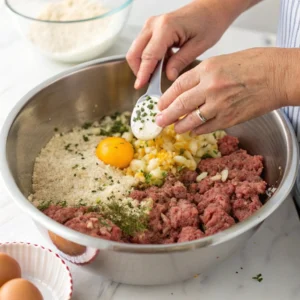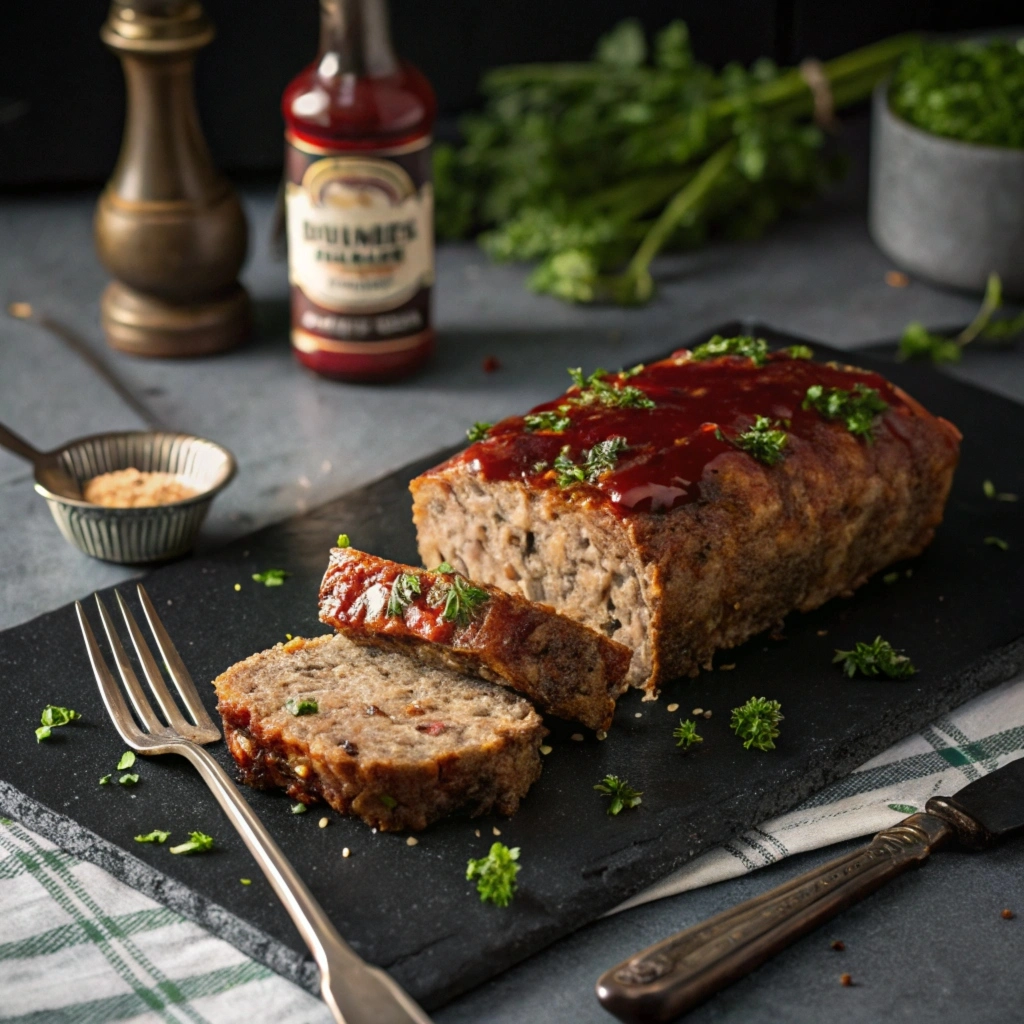Understanding the role of meatloaf cooking temperatures is essential for creating a dish that is safe, flavorful, and perfectly cooked. The right temperature ensures the meatloaf retains its moisture, develops a satisfying texture, and reaches the appropriate internal temperature for food safety. Whether cooking at 350°F for tenderness or 375°F for a crusty exterior, monitoring meatloaf cooking temperatures is key to success.
Cooking temperature plays a critical role in killing harmful bacteria, such as Salmonella or E. coli, and in achieving the perfect balance between a juicy interior and a caramelized exterior. Using a thermometer to measure meatloaf cooking temperatures ensures consistent results and prevents overcooking, which can lead to a dry, tough meatloaf.
By understanding and managing the correct meatloaf cooking temperatures, both home cooks and chefs can consistently create a dish that is not only safe to eat but also delicious and satisfying.
Understanding Meatloaf Composition and Its Impact on Meatloaf Cooking Temperatures
Creating the perfect meatloaf requires understanding its key components: the ingredients, fat content, and the role of binders. These elements work together to influence the texture, flavor, and how the meatloaf reacts to meatloaf cooking temperatures during preparation.
Common Ingredients
 Meatloaf starts with ground meat, such as beef, pork, or turkey, combined with seasonings, vegetables, and binders. These ingredients ensure the meatloaf holds together while cooking. Incorporating vegetables like onions, carrots, or garlic adds moisture, which is especially important when balancing meatloaf cooking temperatures to prevent dryness.
Meatloaf starts with ground meat, such as beef, pork, or turkey, combined with seasonings, vegetables, and binders. These ingredients ensure the meatloaf holds together while cooking. Incorporating vegetables like onions, carrots, or garlic adds moisture, which is especially important when balancing meatloaf cooking temperatures to prevent dryness.
Role of Fat Content
The fat content in the meat affects the flavor and juiciness of the meatloaf. Higher-fat meats, like 80/20 ground beef, remain tender even at higher meatloaf cooking temperatures, such as 375°F. Leaner meats like turkey require additional moisture to avoid becoming dry when exposed to these temperatures. Choosing the right fat content ensures the meatloaf stays moist while reaching the appropriate internal temperature for food safety.
Impact of Binders and Fillers
Binders and fillers, like eggs, breadcrumbs, or oats, play a critical role in meatloaf texture. These ingredients help retain moisture during cooking and ensure the meatloaf holds its shape. Since binders absorb moisture, they are essential for balancing the effects of meatloaf cooking temperatures. Without them, the meatloaf can dry out, especially if cooked at higher oven settings like 375°F.
By understanding these components, you can tailor your meatloaf to handle specific meatloaf cooking temperatures while maintaining flavor, texture, and moisture.
The Science Behind Meatloaf Cooking Temperatures
Understanding the science behind cooking temperatures is essential to creating a flavorful, moist, and perfectly cooked meatloaf. Key factors such as the Maillard reaction, internal temperature for doneness, and moisture retention play critical roles in achieving the desired outcome.
Maillard Reaction and Its Role in Meatloaf Cooking Temperatures
The Maillard reaction is a fundamental chemical process responsible for the browning and development of rich flavors in meatloaf. This reaction occurs when proteins and sugars in the meat and other ingredients interact under heat, typically at temperatures above 300°F (150°C). As the meatloaf cooks, the Maillard reaction creates a browned crust on the surface, enhancing its aroma, texture, and taste. This browning process is crucial for adding depth and complexity to the flavor profile, which would otherwise be absent in an undercooked or improperly browned meatloaf.
Internal Temperature for Perfect Meatloaf Doneness
Achieving the correct internal temperature is vital for ensuring both food safety and quality in meatloaf. The USDA recommends an internal temperature of 160°F (71°C) for ground beef and pork to ensure harmful bacteria like Salmonella or E. coli are destroyed. For poultry-based meatloaf, the internal temperature should reach 165°F (74°C). Measuring the temperature with a food thermometer at the thickest part of the meatloaf is the most accurate way to determine doneness. Cooking meatloaf to these precise temperatures ensures that it is safe to eat without being overcooked, which can lead to a loss of flavor and texture.
How Moisture Retention Varies at Different Meatloaf Cooking Temperatures
Moisture retention is directly impacted by the cooking temperature and duration. At lower temperatures, moisture is retained, but the meat may remain undercooked and lack structural integrity. Conversely, cooking meatloaf at excessively high temperatures causes the proteins to contract too quickly, squeezing out moisture and resulting in a dry, tough texture. Balancing heat is key: baking at 350°F to 375°F (175°C to 190°C) allows the meatloaf to cook evenly, retain moisture, and develop a browned crust without drying out.
Additionally, resting the meatloaf after cooking allows juices to redistribute within the meat, preventing excess moisture loss when slicing. This step ensures a tender and succulent result, rather than a crumbly or dry meatloaf.
By understanding the science behind cooking temperatures, including browning through the Maillard reaction, achieving food safety with proper internal temperatures, and retaining moisture at balanced heat, cooks can perfect their meatloaf preparation every time.
Cooking Meatloaf at 350°F: Balancing Time and Meatloaf Cooking Temperatures
Cooking meatloaf at 350°F (175°C) is a widely recommended method for achieving a tender, evenly cooked dish. This temperature strikes a balance between proper doneness and moisture retention, but it also comes with certain trade-offs, such as a longer cooking time. Understanding how this temperature impacts cooking time, texture outcomes, and overall quality helps ensure a consistently successful meatloaf.
Cooking Time and Texture Outcomes
At 350°F, the meatloaf cooks gradually, allowing heat to penetrate evenly without causing the outer layers to burn or overcook before the center is done. On average, a standard meatloaf weighing 1 to 1.5 pounds requires approximately 50 to 75 minutes to reach an internal temperature of 160°F (71°C) for beef or pork, and 165°F (74°C) for poultry.
This slower cooking process results in a tender texture, as the proteins in the meat do not contract too quickly. The extended time at moderate heat allows for even moisture distribution, preventing the meatloaf from becoming dense or tough. Additionally, the surface of the meatloaf has ample time to develop a flavorful browned crust, thanks to the Maillard reaction.
Advantages: Moisture Retention
One of the key benefits of cooking meatloaf at 350°F is moisture retention. The moderate temperature allows the fats within the meat to render slowly, basting the meatloaf as it cooks. This gradual process minimizes moisture loss, ensuring the meatloaf remains juicy and tender. Lower heat also prevents the surface from becoming dry or tough while the center reaches the proper internal temperature.
Furthermore, cooking at 350°F reduces the risk of overcooking, a common issue at higher temperatures. This advantage makes it easier to achieve a consistently moist meatloaf, which is especially important when using leaner meats like turkey or chicken.
Potential Drawbacks: Longer Cooking Time
Despite its advantages, cooking meatloaf at 350°F does come with the drawback of a longer cooking time. Compared to higher temperatures like 375°F or 400°F, the additional time required can be inconvenient for those seeking a quick meal. For larger meatloaves, the extended cooking time may exceed 90 minutes, making it less practical for busy schedules.
Additionally, while longer cooking enhances tenderness and moisture retention, there is a risk of the meatloaf drying out if not monitored properly. Using a food thermometer to check internal temperature and covering the meatloaf with foil during part of the cooking process can help mitigate this issue.
By cooking meatloaf at 350°F, cooks can achieve a tender, juicy texture with an evenly browned exterior. Although the longer cooking time may be a drawback, the benefits of moisture retention and consistent results make this temperature an excellent choice for a flavorful, satisfying meatloaf.
Cooking Meatloaf at 375°F: Faster Results and Higher Meatloaf Cooking Temperatures
 Cooking meatloaf at 375°F (190°C) is a popular option for those looking to reduce cooking time while still achieving a flavorful, browned crust. This higher temperature offers distinct advantages, such as faster cooking and enhanced surface texture, but it also introduces the risk of drying out the meatloaf if not carefully monitored. Understanding how this temperature affects cooking time, texture, and moisture balance can help cooks make informed decisions when preparing their meatloaf.
Cooking meatloaf at 375°F (190°C) is a popular option for those looking to reduce cooking time while still achieving a flavorful, browned crust. This higher temperature offers distinct advantages, such as faster cooking and enhanced surface texture, but it also introduces the risk of drying out the meatloaf if not carefully monitored. Understanding how this temperature affects cooking time, texture, and moisture balance can help cooks make informed decisions when preparing their meatloaf.
Cooking Time and Texture Outcomes
At 375°F, the meatloaf cooks more quickly compared to lower temperatures, requiring approximately 40 to 55 minutes for a standard 1 to 1.5-pound meatloaf to reach the proper internal temperature. The higher heat accelerates the cooking process, making it ideal for those with limited time.
In terms of texture, cooking at 375°F promotes a firmer exterior with a crisp, well-developed crust. This happens because the higher temperature enhances the Maillard reaction, which produces the browned, caramelized surface that adds depth of flavor. However, while the exterior develops quickly, there is a risk that the center of the meatloaf may dry out or cook unevenly if not managed properly.
Advantages: Faster Cooking, Crust Formation
One of the key benefits of cooking meatloaf at 375°F is the shorter cooking time. By reducing the overall time in the oven, this method is particularly convenient for weeknight meals or when preparing multiple dishes simultaneously.
Another significant advantage is the formation of a flavorful crust on the meatloaf’s surface. The higher heat accelerates browning, resulting in a crisp and caramelized exterior. This crust not only enhances the texture but also adds a layer of rich, savory flavor that contrasts with the tender interior of the meatloaf.
Potential Drawbacks: Risk of Dryness
Despite its benefits, cooking meatloaf at 375°F increases the risk of dryness. The higher temperature causes the proteins in the meat to contract more quickly, which can squeeze out moisture, leaving the meatloaf tough and dry. This is especially problematic for lean meats like ground turkey or chicken, which lack the fat needed to retain moisture.
To counteract this drawback, cooks can take steps to protect the meatloaf. For instance:
- Covering the meatloaf with foil for part of the cooking time can help retain moisture while allowing the interior to cook thoroughly.
- Adding moisture-rich ingredients, such as vegetables, eggs, or sauces, to the mixture can help combat dryness.
- Monitoring the internal temperature with a food thermometer ensures the meatloaf is removed as soon as it reaches 160°F (71°C) for ground beef or pork, and 165°F (74°C) for poultry.
Cooking meatloaf at 375°F strikes a balance between faster cooking times and achieving a flavorful crust. While the risk of dryness is higher, careful monitoring and thoughtful preparation can result in a delicious, moist meatloaf with a crisp, caramelized exterior.
Comparative Analysis of 350°F vs. 375°F Meatloaf Cooking Temperatures
Cooking meatloaf at 350°F and 375°F offers distinct outcomes in terms of texture, flavor, cooking time, and suitability for different meat types. Both temperatures have their advantages and drawbacks, and understanding their impact can help cooks choose the best approach based on time, flavor preferences, and the type of meat used.
Texture and Flavor Differences at Varying Temperatures
At 350°F, the meatloaf cooks gradually, allowing for even heat distribution and better moisture retention. The slower cooking process prevents the proteins from contracting too quickly, resulting in a tender, juicy interior. This temperature also gives the fats more time to render and baste the meatloaf, enhancing its overall flavor. However, the crust formation is less pronounced because the lower heat slows the Maillard reaction responsible for browning and caramelization. The result is a softer exterior with a focus on a moist interior.
At 375°F, the higher heat accelerates crust formation and enhances the Maillard reaction, producing a well-browned, slightly crisp exterior. This browning adds a rich, savory depth to the flavor, which contrasts beautifully with the meatloaf’s interior. However, the faster cooking can lead to moisture loss, especially in leaner meats, resulting in a drier texture if not carefully monitored.
Time Efficiency in Meatloaf Cooking Temperatures
Cooking meatloaf at 350°F requires a longer cooking time, typically 50 to 75 minutes for a 1 to 1.5-pound meatloaf. This slower approach is ideal for ensuring the interior cooks evenly and remains tender, but it may not be convenient for those with limited time.
At 375°F, the cooking time is reduced to approximately 40 to 55 minutes, making it a more time-efficient choice. This faster cooking process is advantageous for busy schedules or weeknight meals. However, the reduced cooking time requires closer monitoring to prevent overcooking and ensure the meatloaf reaches the desired internal temperature.
Best Cooking Temperatures for Different Meat Types
The choice between 350°F and 375°F largely depends on the type of ground meat used:
- Ground Beef and Pork: These fattier meats perform well at both temperatures. At 350°F, the fat renders gradually, keeping the meatloaf moist and flavorful. At 375°F, the exterior develops a satisfying crust without becoming overly dry, provided the cooking time is carefully managed.
- Lean Meats (Turkey or Chicken): Leaner meats are better suited for 350°F because the slower cooking helps retain moisture. At 375°F, the lower fat content increases the risk of dryness, so additional moisture-rich ingredients (e.g., eggs, vegetables, sauces) are essential.
- Blended Meats: Combining fatty and lean meats works well at both temperatures, offering a balance of moisture retention and crust formation.
Discover a delicious and easy-to-follow McCormick meatloaf recipe that brings flavor to every bite. Check it out here: McCormick Meatloaf Recipe.
Frequently Asked Questions (FAQs)
How long does it take to smoke a 2 lb meatloaf?
Smoking a 2-pound meatloaf typically takes about 2.5 to 3 hours at a temperature of 225°F to 250°F (107°C to 121°C). The exact time can vary depending on the smoker’s consistency and the type of meat used. To ensure the meatloaf is properly cooked, monitor the internal temperature with a meat thermometer. The internal temperature should reach 160°F (71°C) for ground beef or pork and 165°F (74°C) for poultry. Smoking at this low and slow temperature allows the meatloaf to absorb a rich, smoky flavor while maintaining moisture and tenderness.
How long do you have to cook a 2 lb meatloaf?
For a 2-pound meatloaf baked in a conventional oven, cooking times will vary depending on the temperature:
- At 350°F (175°C): It takes approximately 1 hour to 1 hour 15 minutes.
- At 375°F (190°C): It will cook faster, in about 45 to 55 minutes.
To confirm doneness, use a meat thermometer to check the internal temperature. It should reach 160°F (71°C) for beef or pork-based meatloaf, and 165°F (74°C) for poultry-based meatloaf. Cooking at a moderate temperature like 350°F ensures the meatloaf remains moist and tender without overcooking.
Does meatloaf stall on a smoker?
Yes, meatloaf can experience a stall on a smoker, similar to larger cuts of meat like brisket or pork shoulder. The stall occurs when the temperature of the meatloaf plateaus, typically between 150°F to 160°F (65°C to 71°C). This happens as moisture from the meat evaporates, cooling the surface and slowing down the cooking process.
To minimize the stall, you can:
- Increase the smoker temperature slightly to 250°F to 275°F.
- Wrap the meatloaf in foil (a technique known as the “Texas crutch”) to reduce evaporation and speed up the cooking process.
However, allowing the meatloaf to remain unwrapped ensures a better crust formation and stronger smoky flavor.
Can you cook meatloaf at 200 degrees?
Yes, you can cook meatloaf at 200°F (93°C), but it will take significantly longer. At this low temperature, a 2-pound meatloaf can take anywhere from 3 to 4 hours to cook thoroughly. Cooking meatloaf at 200°F can produce an exceptionally tender and moist result because the gentle heat prevents the proteins from tightening too quickly, which reduces moisture loss.
However, cooking at such a low temperature may result in minimal crust development. To address this, you can increase the oven temperature to 400°F (200°C) for the final 15–20 minutes to promote browning and caramelization on the surface. Using a glaze during this stage will further enhance the flavor and appearance of the meatloaf.
Always use a meat thermometer to confirm the internal temperature has reached 160°F (71°C) for ground beef or pork, and 165°F (74°C) for poultry, ensuring both safety and quality.
Conclusion
By understanding and managing your meatloaf cooking temperatures, you can consistently produce a moist, flavorful, and perfectly cooked meatloaf. Whether you prefer 350°F for tenderness or 375°F for a crispy crust, the right meatloaf cooking temperatures are key to success.


1 thought on “Meatloaf Guide: Cooking Temperatures”